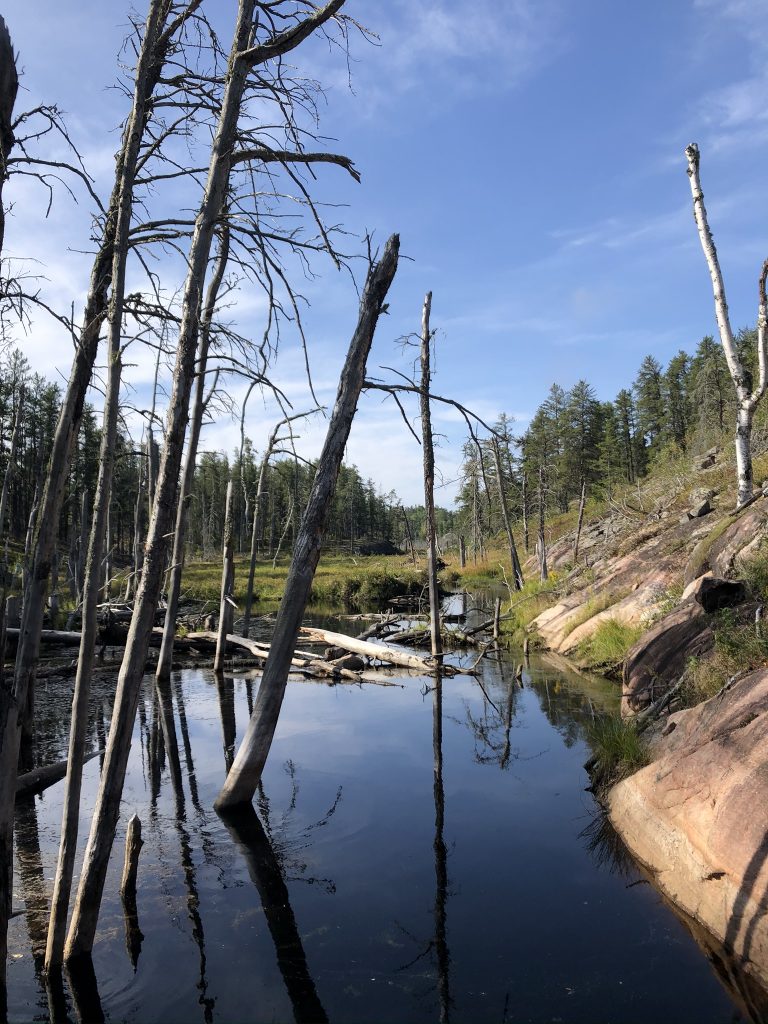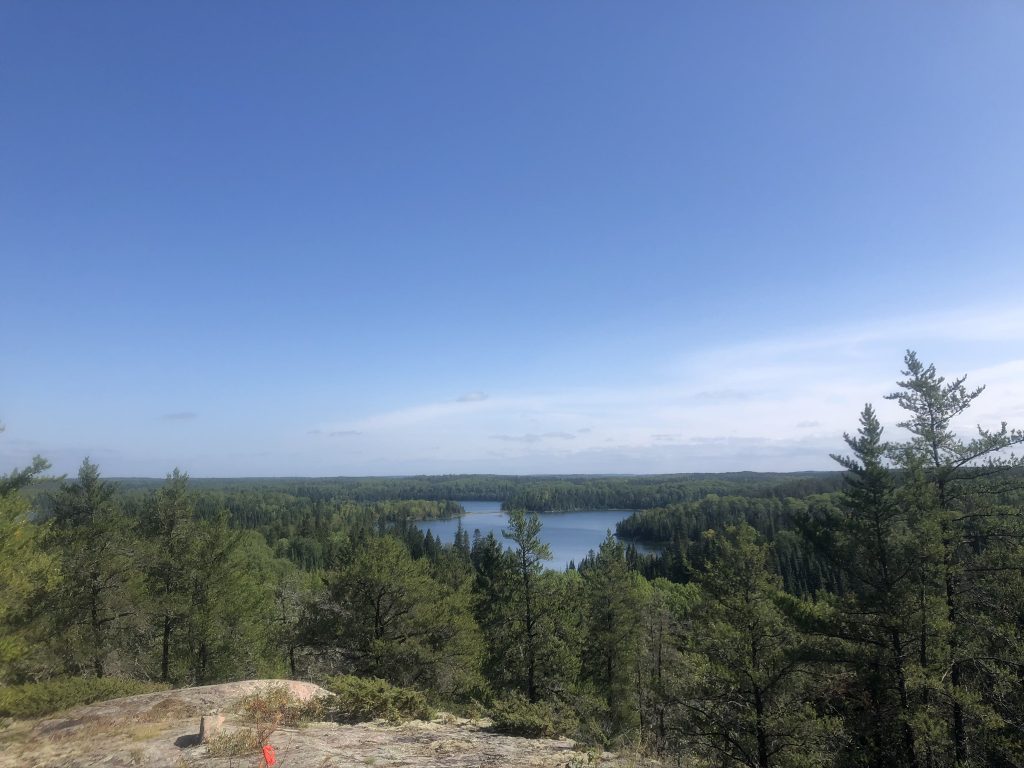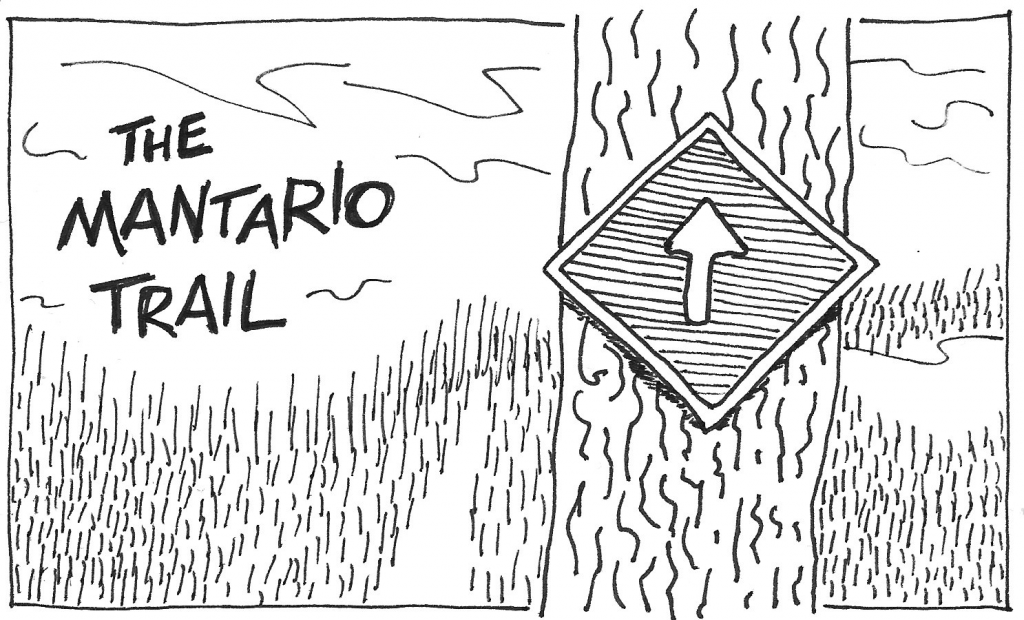
For the past couple years I’ve heard stories about the Mantario Hiking Trail from friends who’d hiked and run it. At about 63km (40 miles) long, it’s not to be taken lightly. The trail was created in 1970s (though I wonder at its prior history), and traces a north-south path through the Mantario Wilderness Zone, over Canadian Shield precambrian rock, through miles of swamp and bog, skirting along pristine lakes, featuring beautiful views along the way. Aside from a few railroad crossing, there are few interactions with the modern world on the trail.
The Mantario Trail has the allure of some of the “great” trails, and presents an irresistible challenge to hikers and runners. Running the trail had been a “someday” kind of dream until, suddenly this year, “someday” got a name: Saturday, September 12.
On this day, a couple friends would be running the trail as part of the Mantario Challenge fundraising event, and a few more of us decided to tag along. The week leading up to the big day was spent mentally tracing the map, thinking through the logistics of obtaining water, keeping my body fuelled, and preparing for the great unknown. I was nervous. We’d run a short section of the trail a few weeks prior, and those couple hours of climbing up rock ridges and carefully descending down wet rocks faces straight into soggy bogs had left me with a great respect for the trail. Although I didn’t doubt that I could complete the trek, I wondered how my body would hold up after 10-12 hours of climbing, slogging, hiking, and, at least occasionally, running. Nature Manitoba claims hiking the whole trail requires 30 hours of hiking time, and recommends 3-4 days to complete. We would be attempting to take the whole trail on one day, within the 13 hours of daylight the early autumn sun would provide.
At the dark hour of 4:35am (yes, in the morning) on September 12, Terry picked me up, and our group of fearless runners drove up to the Whiteshell to begin our epic day.
Exploring is delightful to look forward to and back upon, but it is not comfortable at the time, unless it be of such an easy nature as not to deserve the name.
Samuel Butler, Erewhon, 1872
By the time the sun rose at 7am, we were on the trail. Our group of seven quickly broke up into smaller groups dependent on speed of travel. Terry and the other Terry and I fell into a shared easy pace together. Aside from our one earlier run to Caribou Lake and back a few weeks ago, we were all new to the Mantario. Everything past the first hour or so would be completely new to each of us, and we did our best to take it all in.
My motto for long adventure runs this year has been “move quickly, but don’t hurry.” Nothing ruins a long day on a trail quicker than the feeling of having to rush. Running in itself lends itself to rushing, but it’s not hard to miss the moment, whatever pace you happen to be moving. We stayed content with our pace, making sure to stop to take photos and enjoy the views.
Start slow, and fade.
Kevin Dauwalter #
About 20km in I first had my first stab of doubt. As I hopped to a rock on the trail, a little jab of pain shot through my right knee. This was no time for niggles, and I kept moving forward, monitoring the knee for more signs of damage. The pain flared up a couple more times, whenever I landed a particular way on my right leg. I continued on, feeling it out, hoping I wouldn’t have to turn back or walk it out. Slowly the pain subsided and I was able to continue on, taking some extra care when climbing or descending rock ridges.
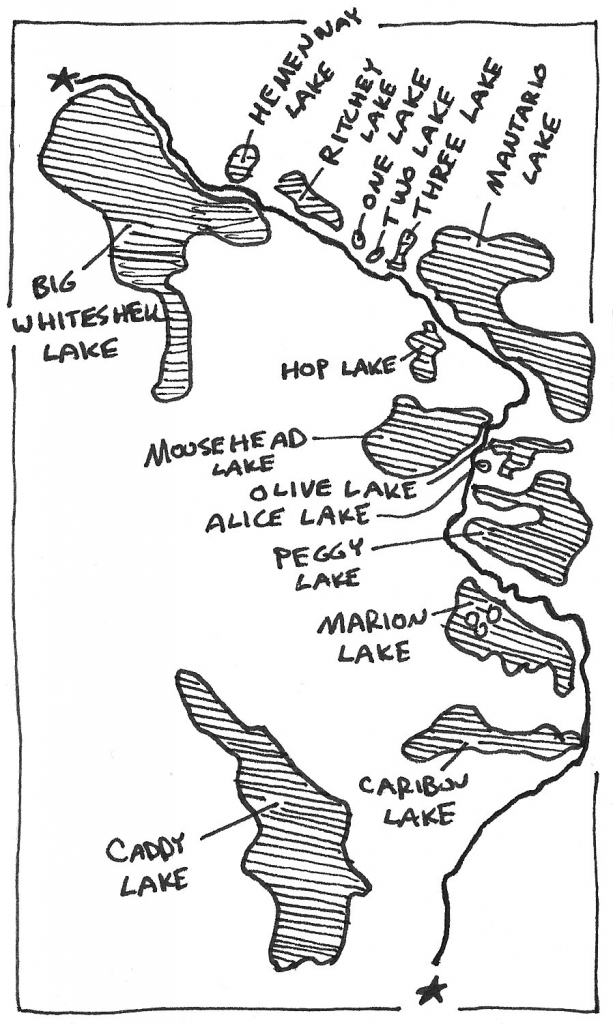
I looked forward to getting to Moosehead Lake, the halfway point of the trail. Though we’d be far from done at this point, there’d be no looking back, knowing the fastest way to the finish would be to keep moving forward. (Although one fellow trail runner reminded me the fastest way out was actually via helicopter, but as fun as that sounded, I didn’t want to think about needing a rescue pick-up.)
A few kilometres before we reached Moosehead, where we would refill our water bottles in the lake, I hit my low point. There’s always a low point (or several) on any long adventure, and this would prove to be my biggest. Out of breath, my leg started to feel sluggish as I struggled to keep up with the Terrys. I ate some of my snacks, hoping they’d help lift my spirits. Then I also remembered my secret weapon, a sweet and salty concoction consisting of pickle juice, lime juice, and syrup (which all tastes better than it sounds), and took a swig. By the time we’d finished our refill break at Moosehead and set off on the 2nd half of the trail, my legs had started to respond, and slowly felt better and better throughout the day.
The trail map had warned us about the difficulty of next stretch of trail, and it wasn’t wrong. Winding up, down, and around huge precambrian rock ridges, this was also one of the most beautiful sections of the trail, featuring sweeping views Mantario Lake and others. These were landscapes most Manitobans would hardly believe existed in a province known for it’s flat prairies and boring, endless highways.
Rock ridges, though, also made for navigational difficulties throughout the trail, as the trail could fizzle out at a moment’s notice atop a large rock face. Several times, as we descended the backside of a ridge to drop back into a forest, our group, which at this point had grown as we joined forces temporarily with another group on the trail, would fan out to search for the next blue sign. The trail, with each blue sign and rock cairn, was our lifeline, the thread that would ensure our safe passage through the wilderness.
Trail runners talk about some trails as being “runnable”, meaning you can easily get into a running rhythm on them and move as quickly as you like. The Mantario is not one of those. The trail, or rather the terrain which the trail helped us navigate, imposed itself upon us, requiring that we go at the pace it required. We submitted to its pace, looking for opportunities to run when possible, between hopping over downed trees, sinking into bogs, and wayfinding.
The woods are lovely, dark and deep, But I have promises to keep, And miles to go before I sleep, And miles to go before I sleep.
Robert Frost
Shortly after passing signs to Ritchey Lake, with the promise of easier trails ahead, we were suddenly slowed to a crawl. Terry, who’d rolled his ankle an hour earlier, realized that he could no longer run on it, slowing him down to a painful walk. We’d agreed at the outset that no one would be left behind, so we also slowed to match his pace. As Mantario rookies, one thing we knew was how quickly you could get into trouble with a missed trail marker or unlucky fall.
Everywhere is within walking distance if you have the time.
Steven Wright
By this point, I also realized I’d made a rookie mistake in my water calculations. Although encouraged to fill all water bottles at Moosehead, I’d left one bottle only half full. Although there are 25 lakes within one kilometre of the Mantario Trail, I was learning that with all the soaring rock cliffs and ridges, not all were easily accessible. I began to ration my water, hoping I’d have enough to get me to the next accessible lake, Hemenway.
At Hemenway Lake, 12km or so from the finish, I finally was able to refill my water bottles, stealing a few eager sips while waiting for the purification tablets to do their thing. Although I felt ok, I knew I was a little dehydrated, which was something I’d struggled with on runs in the past (the most recent of which had sent me racing to the bathroom the moment I got home).
We continued at our walking pace along the northern shore of Big Whiteshell Lake. This may be the most torturous section of the whole trail, as Big Whiteshell represents the final lake of the journey, but is also the largest. And at our pace, the kilometres couldn’t tick by fast enough.
Then, with 5km or so left, my earlier dehydration caught up with me. Just as I took a final swig of my secret pickle juice elixir, the entire contents of my stomach found the fastest route back up and out of my body. Terry kindly took a few steps back on the trail to let me finish up. While sitting on a log recovering my whits, a runner we’d passed earlier in the day caught up with us. “What are you guys doing?” she asked. I don’t remember our reply, but it probably wasn’t entirely honest.
Epic trail adventures can be spoken of with a touch of pride, in the same way a mountain-climber might talk about “conquering” a great mountain peak. And there’s a sense in which I’d approached this challenge with a desire to conquer the Mantario. But, in the process of completing the trail, I felt less like a conqueror, and more like I myself had been conquered.
On a trail, to walk is to follow. Like prostration or apprenticeship, trail walking both requires and installs a certain measure of humility.
Robert Moor, On Trails
We continued until we reached the North Trailhead and the end of our journey, to the congratulations of some of the Mantario Challenge finishers. Getting there (and realizing the distinct lack of amenities, such as water or cell service), we sat down directly on the asphalt, tired, aching, finished.
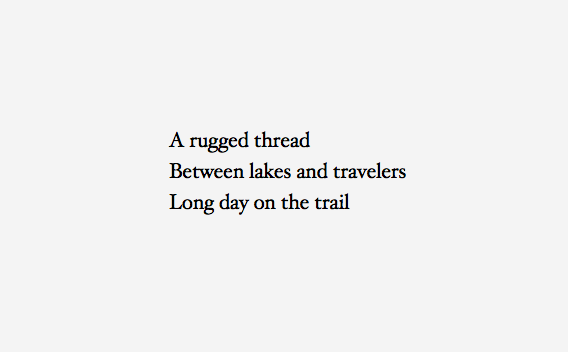
The next day our running group would text back and forth about our various aches and pains, stating how we’d permanently “retired” from running, while simultaneously looking ahead expectantly to the next adventure ahead.

